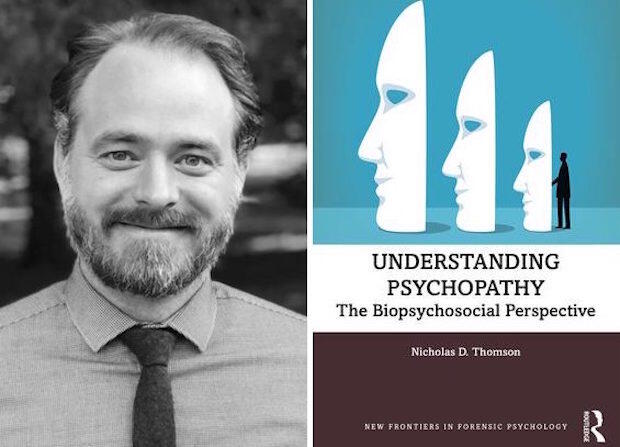
April 3, 2019
Understanding psychopathy
Share this story
By Ahniaelyah Spraggs
As a teaching fellow at Durham University in the United Kingdom, Nicholas Thomson, Ph.D., struggled finding the right textbook on psychopathy for his students. So Thomson, now a forensic psychologist with VCU Health’s Injury and Violence Prevention Program, set out to write his own.
That book, “Understanding Psychopathy: The Biopsychosocial Perspective,” comes out April 11. The book looks at psychopathy through the biopsychosocial model, which combines research from the social sciences, biology and psychology. Combining the various research insights will lead to more refined treatment and prevention approaches to psychopathy, Thomson said.
VCU News interviewed Thomson about his book, and about the factors that contribute to psychopathy.
What is a psychopath?
The gold standard for assessing psychopathy is using the Hare Psychopathy Checklist-Revised, which is a clinical assessment that measures 20 personality and behavioral symptoms. Essentially, a psychopath is someone who meets the diagnostic criteria on this scale, which requires a score of 30 or more, although a cutoff score of 25 is frequently used in Europe and for women. Based on the criteria, a psychopath is someone who is superficially charming, manipulative, grandiose, displays a callous lack of empathy, has no remorse, and blames others for their actions. This means the psychopath is able to con and use others for their own personal gain, without being concerned about hurting or impacting others in the process. The psychopath is an opportunist; it doesn’t matter if the victim is a family member, colleague or a stranger. The psychopath typically has an extensive history of criminal behaviors and childhood delinquency and lacks long-term goals.
What factors contribute to someone becoming a psychopath? Is there one factor that overrides the others?
There is no one cause of psychopathy and this is what is discussed throughout the book using research from the past 40-plus years. Although genetic research demonstrates that genes are responsible for 40 to 60 percent of the development of psychopathy, there is no single gene that causes psychopathy. Therefore, the development of psychopathy is contingent on the combination and interaction of biological, psychological and social risk factors. Instead of one causal factor, we should expect multiple risk factors that contribute to the development of specific psychopathic symptoms [such as] a lack of empathy. As with all personality disorders, they are complex, so we should expect a complex answer to what makes a psychopath. This is why the biopsychosocial model is so significant for understanding psychopathy.
The term “psychopath” is often used loosely in today's society. What are some misconceptions about psychopaths that this book might clear up?
There are quite a number. The one that concerns me most is when I see people, including academics, who glorify psychopathy as a functional/successful disorder that can be an advantage to society. Unfortunately, it is this perspective that often attracts a large audience, perpetuating the falsity. As any clinician who has worked with psychopaths, or a person who has become the victim of a psychopath knows, there is no doubt that psychopathy is not functional or a positive disorder to have.
Although most psychopaths do not commit serial homicides, they are responsible for a significant proportion of violent crime in the U.S. Psychopaths make up about 1 to 2 percent of the general population, yet, they are responsible for about 40 percent of all violent crime. Even for those psychopaths who are not convicted for their violence, they still find ways to harm others — it is by their very nature to use others for their own personal gain. This is by no means successful.
How is this book different from other books on the topic?
There are some excellent books out there on psychopathy, including the “Handbook of Psychopathy” edited by Christopher Patrick, Ph.D., and “Psychopathy: An Introduction to Biological Findings and Their Implications” by Adrian Raine, Ph.D., and Andrea Glenn, Ph.D.
“Understanding Psychopathy” is different primarily because the focus is to provide an overview of the research conducted since the study of psychopathy began, and to illustrate how psychopathy is best understood using the biopsychosocial model. To fully understand the development of psychopathy, we need to recognize and integrate the research from multiple disciplines. This book comprehensively provides researchers and clinicians with a review of the research from biological (e.g., genetics, neuroimaging, psychophysiology), psychological (e.g., morals, personality traits, neurocognitive function) and social sciences (e.g., parenting, childhood exposures, peers). Throughout the book, I use real case studies to illustrate the severity of psychopathy and the strength of the biopsychosocial model. Although the biopsychosocial model has been around for some time, this is the first book to fully address how psychopathy is best understood using the biopsychosocial perspective, which means the reader is provided with a more complete and current understanding of psychopathy and how to develop treatments for psychopathy.
All author proceeds are being donated to Project Empower at VCU Health, a multidisciplinary initiative. Project Empower is dedicated to enhancing prevention and intervention services to individuals and their families who experience intimate partner violence, sexual violence, domestic violence, or human trafficking.
Editor's note: This story has been updated to correct Nicholas Thomson's title at Durham University. He was a teaching fellow, not a professor, as originally written.
Subscribe to VCU News
Subscribe to VCU News at newsletter.vcu.edu and receive a selection of stories, videos, photos, news clips and event listings in your inbox.









